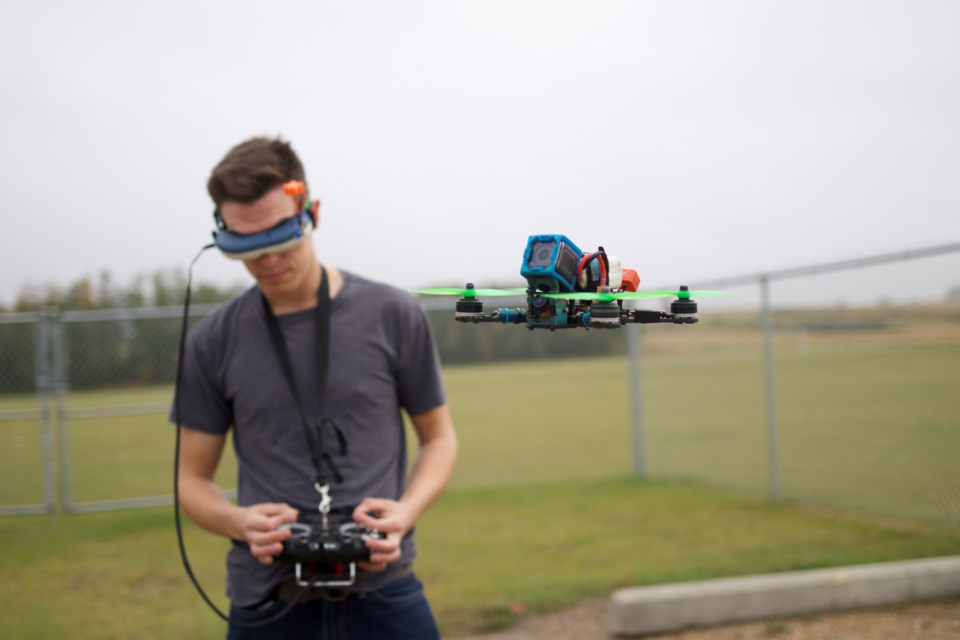You may have seen them flying through the sky (although almost too quick to catch), or heard them and mistaken their buzz for a large insect, but don’t worry. When flown responsibly, drones are harmless.
The sport of drone racing has been gaining momentum in the past few years as more pilots from across Canada and the world band together with drone racing leagues to host races and compete for large sums of cash and bragging rights. But as drone racing becomes more popular, so does another style of flying: freestyle.
Unlike drone racing, where pilots fly through carefully constructed race tracks and reach speeds up to 100 kilometres per hour, freestyle pilots use natural landscapes and architecture as their track.
Paul Paradis is a freestyle drone pilot from Gibbons and has been flying freestyle for two and a half years. Like almost every drone pilot, Paradis was first inspired to fly by videos he saw on YouTube.
“I watched a YouTube video by this guy named Charpu and it absolutely blew my mind,” Paradis said. “I couldn’t believe how he could do these acrobatic tricks while flying through a building. I was completely enamoured by it.”
Freestyle flying focuses less on competition and speed and more on tricks and accuracy.
“(Freestyle flying) is an expression of self and I’m constantly getting better and better and more inventive,” Paradis said.
But as with any other sport, tricks and accuracy only improve with practise, dedication and breaks for your brain and body to retain what you are learning.
“ 'Just flying’ is like riding a bike,” Paradis said. “Whereas you have to have some real-time internal calculations to try anything awe-inspiring.
“I find myself flying quite inaccurately and erratically after about three days of flying. You really have to let yourself fall into practiced knowledge and instincts while flying as opposed to actually analyzing and reacting as you fly. You need that extra headspace to formulate what you’re going to do next.”
Alberta hosts some beautiful landscapes and architecture to fly, but of course, as with any sport, rules apply, and new rules regarding recreational and commercial drone flying came into effect in Canada June 1.
Paradis enjoys flying at two legal locations: The Science Park just east of Edmonton and the grain elevator by his home in Gibbons. Both locations follow the new rules when it comes to recreational flying and are safe spots to hone your skills.
“I couldn’t even tell you what my dream location would be,” Paradis said. “I guess this abandoned island in Japan that is well kept and has a lot of buildings, or the Edmonton River Valley for cinematography. But I don’t want to risk losing my drone.”
Flying location restrictions aren’t the only rules pilots need to pay attention to now. The weights of drones that require special licences and certificates have also changed.
Under the old rules, a drone under 35 kg does not require a special licence. That weight has dropped by 10 kg and now includes any drones between 250 grams and 25 kg. In this weight class, all drones must be registered with the government as well; a new way to keep track of drone pilots and their aircrafts in Canada.
While pilots who are flying drones under 250 grams (micro drones) don’t need to register their drones and don’t require a special licence, they are still expected to follow the rules of responsible flying.
The type of flying also affects whether or not pilots need licences and registration.
Canada has two categories for drone operations: basic and advanced. While all drones must be registered regardless of type of operations, the licence type changes.
Basic operations include basic recreational flying of drones within the new weight class. To qualify as basic operations, the pilot must be flying in an uncontrolled airspace at least 30 metres from bystanders while never flying over top of them.
If a pilot does not meet one of the three requirements, then they fall under advanced flight operations (commercial flying) and require an advanced operations pilot certificate. With an advanced operations pilot certificate, pilots don’t need to worry about having a separate licence for basic operations.
Flying safely and responsibly is an important part of flying drones whether people choose to race, fly freestyle or fly drones as part of commercial work.
Paradis holds a basic operator’s license for his freestyle flying, which usually falls under basic operations unless someone is performing at an event.
Paradis hopes to get a group going for freestyle pilots in Alberta.
“There’s a lot of us. We were at Suncor flying and some guy just happened to come out of Suncor and said, ‘Hey I fly that too,’ ” Paradis said, laughing. “It blew my mind because we were thinking he was going to come get mad at us.”
While flying drones isn’t the easiest sport or hobby to pick up, Paradis has advice for people looking to hit the skies and take up freestyle flying.
“Watch more YouTube videos than you think you should and fly simulators.”
The new rules for drone operations came into effect on June 1, 2019.




